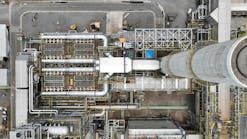CSB draft report says neglect led to Chevron Richmond refinery fire
A failure to apply an inherently safer design, identify and evaluate damage mechanism hazards, and use effective safeguards led to an Aug. 6, 2012, pipe rupture and vapor release that ignited and shut down the No. 4 crude oil unit at Chevron USA Inc.’s Richmond, Calif., refinery, the US Chemical Safety Board said in a draft report.
Investigators found that Chevron did not apply inherently safer design principles and upgrade piping in the unit over 10 years, leading to extreme corrosion that ultimately made the pipe rupture and release a vapor cloud that ultimately caught fire, endangering 19 workers who had narrowly escaped moments earlier, CSB said.
“Chevron failed to replace critical sections of piping in the crude oil unit over a 10-year period,” CSB Chairman Rafael Moure-Eraso told reporters at an Apr. 15 briefing in the Northern California community. “This incident would not have occurred if it had followed its own internal regulations to implement improved technology.”
If Chevron had done this, or if government regulators had required it to implement safer technology, it would have upgraded critical crude unit sidecut piping years ago from carbon steel to metallurgy more resistant to sulfidation corrosion, the draft report said. Such a material upgrade could have prevented the accident, it added.
“Chevron had resources, time, and technical expertise to know the risk. However, there was no effective intervention before an accident could occur,” Moure-Eraso said. “Make no mistake: The ultimate issue is not corrosion, but how to make effective corporate decisions. Regulators also need effective tools and resources to encourage companies to make the right choices.”
The CSB draft report said that even when rebuilding the crude oil unit after the August 2012 release and fire, Chevron did not install what the CSB considers inherently safer stainless steel piping in the destroyed distillation tower, choosing instead, with no documented inherently safer technology review, an alloy called 9-Chrome that is more corrosion-resistant than carbon steel but less resistant than stainless steel.
Acted at El Segundo
It did this despite the company’s installing stainless steel piping in the 4-sidecut section of the distillation tower in a nearly identical refinery unit at El Segundo, Calif., in 2001, considering it to be the safest material, CSB investigators found.
The draft report is subject to a CSB vote on Apr. 19 in Richmond. There also will be a public meeting that day at the city’s civic center where CSB investigators will discuss their investigation in detail and public comments will be heard.
CSB said its investigators recommended that Chevron perform damage mechanism hazard reviews and ensure safeguards are in place to control identified hazards at all of its refineries. It also called for reporting of process safety indicators to enable more effective oversight by federal, state, and local regulatory agencies.
The problems uncovered in this investigation should be addressed by all US refiners and government regulators at all levels, CSB’s chairman said. “The refining industry should open its doors to public scrutiny, including information about deferred maintenance and use of safer technology,” he suggested.
“Regulatory agencies are under-resourced to do the required inspections and audits,” Moure-Eraso said. “The report shows the need for companies to not only review corrosion, but also to document and explain deferred maintenance decisions.”
Contact Nick Snow at [email protected].

Nick Snow
NICK SNOW covered oil and gas in Washington for more than 30 years. He worked in several capacities for The Oil Daily and was founding editor of Petroleum Finance Week before joining OGJ as its Washington correspondent in September 2005 and becoming its full-time Washington editor in October 2007. He retired from OGJ in January 2020.

